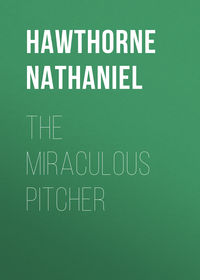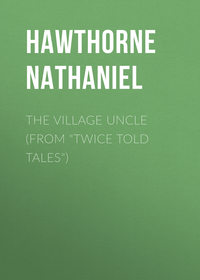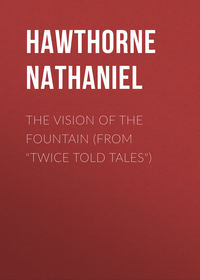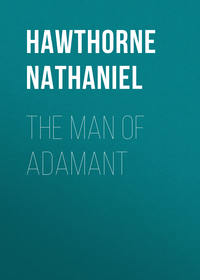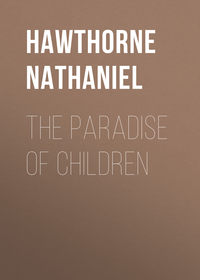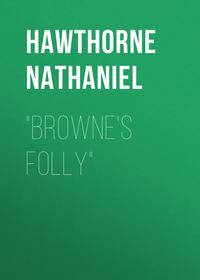 полная версия
полная версияOur Old Home. Volume 2
Our ride to Ayr presented nothing very remarkable; and, indeed, a cloudy and rainy day takes the varnish off the scenery, and causes a woful diminution in the beauty and impressiveness of everything we see. Much of our way lay along a flat, sandy level, in a southerly direction. We reached Ayr in the midst of hopeless rain, and drove to the King's Arms Hotel. In the intervals of showers I took peeps at the town, which appeared to have many modern or modern-fronted edifices; although there are likewise tall, gray, gabled, and quaint-looking houses in the by-streets, here and there, betokening an ancient place. The town lies on both sides of the Ayr, which is here broad and stately, and bordered with dwellings that look from their windows directly down into the passing tide.
I crossed the river by a modern and handsome stone bridge, and recrossed it, at no great distance, by a venerable structure of four gray arches, which must have bestridden the stream ever since the early days of Scottish history. These are the "Two Briggs of Ayr," whose midnight conversation was overheard by Burns, while other auditors were aware only of the rush and rumble of the wintry stream among the arches. The ancient bridge is steep and narrow, and paved like a street, and defended by a parapet of red freestone, except at the two ends, where some mean old shops allow scanty room for the pathway to creep between. Nothing else impressed me hereabouts, unless I mention that, during the rain, the women and girls went about the streets of Ayr barefooted to save their shoes.
The next morning wore a lowering aspect as if it felt itself destined to be one of many consecutive days of storm. After a good Scotch breakfast, however, of fresh herrings and eggs, we took a fly, and started at a little past ten for the banks of the Doon. On our way, at about two miles from Ayr, we drew up at a roadside cottage, on which was an inscription to the effect that Robert Burns was born within its walls. It is now a public house; and, of course, we alighted and entered its little sitting-room, which, as we at present see it, is a neat apartment with the modern improvement of a ceiling. The walls are much overscribbled with names of visitors, and the wooden door of a cupboard in the wainscot, as well as all the other wood-work of the room, is cut and carved with initial letters. So, likewise, are two tables, which, having received a coat of varnish over the inscriptions, form really curious and interesting articles of furniture. I have seldom (though I do not personally adopt this mode of illustrating my humble name) felt inclined to ridicule the natural impulse of most people thus to record themselves at the shrines of poets and heroes.
On a panel, let into the wall in a corner of the room, is a portrait of Burns, copied from the original picture by Nasmyth. The floor of this apartment is of boards, which are probably a recent substitute for the ordinary flag-stones of a peasant's cottage. There is but one other room pertaining to the genuine birthplace of Robert Burns: it is the kitchen, into which we now went. It has a floor of flag-stones, even ruder than those of Shakespeare's house, – though, perhaps, not so strangely cracked and broken as the latter, over which the hoof of Satan himself might seem to have been trampling. A new window has been opened through the wall, towards the road; but on the opposite side is the little original window, of only four small panes, through which came the first daylight that shone upon the Scottish poet. At the side of the room, opposite the fireplace, is a recess, containing a bed, which can be hidden by curtains. In that humble nook, of all places in the world, Providence was pleased to deposit the germ of richest human life which mankind then had within its circumference.
These two rooms, as I have said, make up the whole sum and substance of Burns's birthplace: for there were no chambers, nor even attics; and the thatched roof formed the only ceiling of kitchen and sitting-room, the height of which was that of the whole house. The cottage, however, is attached to another edifice of the same size and description, as these little habitations often are; and, moreover, a splendid addition has been made to it, since the poet's renown began to draw visitors to the wayside alehouse. The old woman of the house led us through an entry, and showed a vaulted hall, of no vast dimensions, to be sure, but marvelously large and splendid as compared with what might be anticipated from the outward aspect of the cottage. It contained a bust of Burns, and was hung round with pictures and engravings, principally illustrative of his life and poems. In this part of the house, too, there is a parlor, fragrant with tobacco-smoke; and, no doubt, many a noggin of whiskey is here quaffed to the memory of the bard, who professed to draw so much inspiration from that potent liquor.
We bought some engravings of Kirk Alloway, the Bridge of Doon, and the monument, and gave the old woman a fee besides, and took our leave. A very short drive farther brought us within sight of the monument, and to the hotel, situated close by the entrance of the ornamental grounds within which the former is inclosed. We rang the bell at the gate of the inclosure, but were forced to wait a considerable time; because the old man, the regular superintendent of the spot, had gone to assist at the laying of the corner-stone of a new kirk. He appeared anon, and admitted us, but immediately hurried away to be present at the concluding ceremonies, leaving us locked up with Burns.
The inclosure around the monument is beautifully laid out as an ornamental garden, and abundantly provided with rare flowers and shrubbery, all tended with loving care. The monument stands on an elevated site, and consists of a massive basement story, three-sided, above which rises a light and elegant Grecian temple, – a mere dome, supported on Corinthian pillars, and open to all the winds. The edifice is beautiful in itself; though I know not what peculiar appropriateness it may have, as the memorial of a Scottish rural poet.
The door of the basement story stood open; and, entering, we saw a bust of Burns in a niche, looking keener, more refined, but not so warm and whole-souled as his pictures usually do. I think the likeness cannot be good. In the centre of the room stood a glass case, in which were reposited the two volumes of the little Pocket Bible that Burns gave to Highland Mary, when they pledged their troth to one another. It is poorly printed on coarse paper. A verse of Scripture referring to the solemnity and awfulness of vows is written within the cover of each volume, in the poet's own hand; and fastened to one of the covers is a lock of Highland Mary's golden hair. This Bible had been carried to America by one of her relatives, but was sent back to be fitly treasured here.
There is a staircase within the monument, by which we ascended to the top, and had a view of both Briggs of Doon: the scene of Tam O'Shanter's misadventure being close at hand. Descending, we wandered through the inclosed garden, and came to a little building in a corner, on entering which, we found the two statues of Tam and Sutor Wat, – ponderous stone-work enough, yet permeated in a remarkable degree with living warmth and jovial hilarity. From this part of the garden, too, we again beheld the old Brigg of Doon, over which Tam galloped in such imminent and awful peril. It is a beautiful object in the landscape, with one high, graceful arch, ivy-grown, and shadowed all over and around with foliage.
When we had waited a good while, the old gardener came, telling us that he had heard an excellent prayer at laying the corner-stone of the new kirk. He now gave us some roses and sweetbrier, and let us out from his pleasant garden. We immediately hastened to Kirk Alloway, which is within two or three minutes' walk of the monument. A few steps ascend from the roadside, through a gate, into the old graveyard, in the midst of which stands the kirk. The edifice is wholly roofless, but the side-walls and gable-ends are quite entire, though portions of them are evidently modern restorations. Never was there a plainer little church, or one with smaller architectural pretensions; no New England meeting-house has more simplicity in its very self, though poetry and fun have clambered and clustered so wildly over Kirk Alloway that it is difficult to see it as it actually exists. By the by, I do not understand why Satan and an assembly of witches should hold their revels within a consecrated precinct; but the weird scene has so established itself in the world's imaginative faith that it must be accepted as an authentic incident, in spite of rule and reason to the contrary. Possibly, some carnal minister, some priest of pious aspect and hidden infidelity, had dispelled the consecration of the holy edifice by his pretense of prayer, and thus made it the resort of unhappy ghosts and sorcerers and devils.
The interior of the kirk, even now, is applied to quite as impertinent a purpose as when Satan and the witches used it as a dancing-hall; for it is divided in the midst by a wall of stone-masonry, and each compartment has been converted into a family burial-place. The name on one of the monuments is Crawfurd; the other bore no inscription. It is impossible not to feel that these good people, whoever they may be, had no business to thrust their prosaic bones into a spot that belongs to the world, and where their presence jars with the emotions, be they sad or gay, which the pilgrim brings thither. They shut us out from our own precincts, too, – from that inalienable possession which Burns bestowed in free gift upon mankind, by taking it from the actual earth and annexing it to the domain of imagination. And here these wretched squatters have lain down to their long sleep, after barring each of the two doorways of the kirk with an iron grate! May their rest be troubled, till they rise and let us in!
Kirk Alloway is inconceivably small, considering how large a space it fills in our imagination before we see it. I paced its length, outside of the wall, and found it only seventeen of my paces, and not more than ten of them in breadth. There seem to have been but very few windows, all of which, if I rightly remember, are now blocked up with mason-work of stone. One mullioned window, tall and narrow, in the eastern gable, might have been seen by Tam O'Shanter, blazing with devilish light, as he approached along the road from Ayr; and there is a small and square one, on the side nearest the road, into which he might have peered, as he sat on horseback. Indeed, I could easily have looked through it, standing on the ground, had not the opening been walled up. There is an odd kind of belfry at the peak of one of the gables, with the small bell still hanging in it. And this is all that I remember of Kirk Alloway, except that the stones of its material are gray and irregular.
The road from Ayr passes Alloway Kirk, and crosses the Doon by a modern bridge, without swerving much from a straight line. To reach the old bridge, it appears to have made a bend, shortly after passing the kirk, and then to have turned sharply towards the river. The new bridge is within a minute's walk of the monument; and we went thither, and leaned over its parapet to admire the beautiful Doon, flowing wildly and sweetly between its deep and wooded banks. I never saw a lovelier scene; although this might have been even lovelier if a kindly sun had shone upon it. The ivy-grown, ancient bridge, with its high arch, through which we had a picture of the river and the green banks beyond, was absolutely the most picturesque object, in a quiet and gentle way, that ever blessed my eyes. Bonny Doon, with its wooded banks, and the boughs dipping into the water! The memory of them, at this moment, affects me like the song of birds, and Burns crooning some verses, simple and wild, in accordance with their native melody.
It was impossible to depart without crossing the very bridge of Tam's adventure; so we went thither, over a now disused portion of the road, and, standing on the centre of the arch, gathered some ivy-leaves from that sacred spot. This done, we returned as speedily as might be to Ayr, whence, taking the rail, we soon beheld Ailsa Craig rising like a pyramid out of the sea. Drawing nearer to Glasgow, Ben Lomond hove in sight, with a dome-like summit, supported by a shoulder on each side. But a man is better than a mountain; and we had been holding intercourse, if not with the reality, at least with the stalwart ghost of one of Earth's memorable sons, amid the scenes where he lived and sung. We shall appreciate him better as a poet, hereafter; for there is no writer whose life, as a man, has so much to do with his fame, and throws such a necessary light upon whatever he has produced. Henceforth, there will be a personal warmth for us in everything that he wrote; and, like his countrymen, we shall know him in a kind of personal way, as if we had shaken hands with him, and felt the thrill of his actual voice.
IX.
A LONDON SUBURB
One of our English summers looks, in the retrospect, as if it had been patched with more frequent sunshine than the sky of England ordinarily affords; but I believe that it may be only a moral effect, – a "light that never was on sea or land," – caused by our having found a particularly delightful abode in the neighborhood of London. In order to enjoy it, however, I was compelled to solve the problem of living in two places at once, – an impossibility which I so far accomplished as to vanish, at frequent intervals, out of men's sight and knowledge on one side of England, and take my place in a circle of familiar faces on the other, so quietly that I seemed to have been there all along. It was the easier to get accustomed to our new residence, because it was not only rich in all the material properties of a home, but had also the home-like atmosphere, the household element, which is of too intangible a character to be let even with the most thoroughly furnished lodging-house. A friend had given us his suburban residence, with all its conveniences, elegances, and snuggeries, – its drawing-rooms and library, still warm and bright with the recollection of the genial presences that we had known there, – its closets, chambers, kitchen, and even its wine-cellar, if we could have availed ourselves of so dear and delicate a trust, – its lawn and cosey garden-nooks, and whatever else makes up the multitudinous idea of an English home, – he had transferred it all to us, pilgrims and dusty wayfarers, that we might rest and take our ease during his summer's absence on the Continent. We had long been dwelling in tents, as it were, and morally shivering by hearths which, heap the bituminous coal upon them as we might, no blaze could render cheerful. I remember, to this day, the dreary feeling with which I sat by our first English fireside, and watched the chill and rainy twilight of an autumn day darkening down upon the garden; while the portrait of the preceding occupant of the house (evidently a most unamiable personage in his lifetime) scowled inhospitably from above the mantelpiece, as if indignant that an American should try to make himself at home there. Possibly it may appease his sulky shade to know that I quitted his abode as much a stranger as I entered it. But now, at last, we were in a genuine British home, where refined and warm-hearted people had just been living their daily life, and had left us a summer's inheritance of slowly ripened days, such as a stranger's hasty opportunities so seldom permit him to enjoy.
Within so trifling a distance of the central spot of all the world (which, as Americans have at present no centre of their own, we may allow to be somewhere in the vicinity, we will say, of St. Paul's Cathedral), it might have seemed natural that I should be tossed about by the turbulence of the vast London whirlpool. But I had drifted into a still eddy, where conflicting movements made a repose, and, wearied with a good deal of uncongenial activity, I found the quiet of my temporary haven more attractive than anything that the great town could offer. I already knew London well; that is to say, I had long ago satisfied (so far as it was capable of satisfaction) that mysterious yearning – the magnetism of millions of hearts operating upon one – which impels every man's individuality to mingle itself with the immensest mass of human life within his scope. Day after day, at an earlier period, I had trodden the thronged thoroughfares, the broad, lonely squares, the lanes, alleys, and strange labyrinthine courts, the parks, the gardens and inclosures of ancient studious societies, so retired and silent amid the city uproar, the markets, the foggy streets along the riverside, the bridges, – I had sought all parts of the metropolis, in short, with an unweariable and indiscriminating curiosity; until few of the native inhabitants, I fancy, had turned so many of its corners as myself. These aimless wanderings (in which my prime purpose and achievement were to lose my way, and so to find it the more surely) had brought me, at one time or another, to the sight and actual presence of almost all the objects and renowned localities that I had read about, and which had made London the dream-city of my youth. I had found it better than my dream; for there is nothing else in life comparable (in that species of enjoyment, I mean) to the thick, heavy, oppressive, sombre delight which an American is sensible of, hardly knowing whether to call it a pleasure or a pain, in the atmosphere of London. The result was, that I acquired a home-feeling there, as nowhere else in the world, – though afterwards I came to have a somewhat similar sentiment in regard to Rome; and as long as either of those two great cities shall exist, the cities of the Past and of the Present, a man's native soil may crumble beneath his feet without leaving him altogether homeless upon earth.
Thus, having once fully yielded to its influence, I was in a manner free of the city, and could approach or keep away from it as I pleased. Hence it happened that, living within a quarter of an hour's rush of the London Bridge Terminus, I was oftener tempted to spend a whole summer day in our garden than to seek anything new or old, wonderful or commonplace, beyond its precincts. It was a delightful garden, of no great extent, but comprising a good many facilities for repose and enjoyment, such as arbors and garden-seats, shrubbery, flower-beds, rose-bushes in a profusion of bloom, pinks, poppies, geraniums, sweetpeas, and a variety of other scarlet, yellow, blue, and purple blossoms, which I did not trouble myself to recognize individually, yet had always a vague sense of their beauty about me. The dim sky of England has a most happy effect on the coloring of flowers, blending richness with delicacy in the same texture; but in this garden, as everywhere else, the exuberance of English verdure had a greater charm than any tropical splendor or diversity of hue. The hunger for natural beauty might be satisfied with grass and green leaves forever. Conscious of the triumph of England in this respect, and loyally anxious for the credit of my own country, it gratified me to observe what trouble and pains the English gardeners are fain to throw away in producing a few sour plums and abortive pears and apples, – as, for example, in this very garden, where a row of unhappy trees were spread out perfectly flat against a brick wall, looking as if impaled alive, or crucified, with a cruel and unattainable purpose of compelling them to produce rich fruit by torture. For my part, I never ate an English fruit, raised in the open air, that could compare in flavor with a Yankee turnip.
The garden included that prime feature of English domestic scenery, a lawn. It had been leveled, carefully shorn, and converted into a bowling-green, on which we sometimes essayed to practice the time-honored game of bowls, most unskillfully, yet not without a perception that it involves a very pleasant mixture of exercise and ease, as is the case with most of the old English pastimes. Our little domain was shut in by the house on one side, and in other directions by a hedge-fence and a brick wall, which last was concealed or softened by shrubbery and the impaled fruit-trees already mentioned. Over all the outer region, beyond our immediate precincts, there was an abundance of foliage, tossed aloft from the near or distant trees with which that agreeable suburb is adorned. The effect was wonderfully sylvan and rural, insomuch that we might have fancied ourselves in the depths of a wooded seclusion; only that, at brief intervals, we could hear the galloping sweep of a railway-train passing within a quarter of a mile, and its discordant screech, moderated by a little farther distance, as it reached the Blackheath Station. That harsh, rough sound, seeking me out so inevitably, was the voice of the great world summoning me forth. I know not whether I was the more pained or pleased to be thus constantly put in mind of the neighborhood of London; for, on the one hand, my conscience stung me a little for reading a book, or playing with children in the grass, when there were so many better things for an enlightened traveler to do, – while, at the same time, it gave a deeper delight to my luxurious idleness to contrast it with the turmoil which I escaped. On the whole, however, I do not repent of a single wasted hour, and only wish that I could have spent twice as many in the same way; for the impression on my memory is, that I was as happy in that hospitable garden as the English summer day was long.
One chief condition of my enjoyment was the weather. Italy has nothing like it, nor America. There never was such weather except in England, where, in requital of a vast amount of horrible east wind between February and June, and a brown October and black November, and a wet, chill, sunless winter, there are a few weeks of incomparable summer, scattered through July and August, and the earlier portion of September, small in quantity, but exquisite enough to atone for the whole year's atmospherical delinquencies. After all, the prevalent sombreness may have brought out those sunny intervals in such high relief that I see them, in my recollection, brighter than they really were: a little light makes a glory for people who live habitually in a gray gloom. The English, however, do not seem to know how enjoyable the momentary gleams of their summer are; they call it broiling weather, and hurry to the seaside with red, perspiring faces, in a state of combustion and deliquescence; and I have observed that even their cattle have similar susceptibilities, seeking the deepest shade, or standing midleg deep in pools and streams to cool themselves, at temperatures which our own cows would deem little more than barely comfortable. To myself, after the summer heats of my native land had somewhat effervesced out of my blood and memory, it was the weather of Paradise itself. It might be a little too warm; but it was that modest and inestimable superabundance which constitutes a bounty of Providence, instead of just a niggardly enough. During my first year in England, residing in perhaps the most ungenial part of the kingdom, I could never be quite comfortable without a fire on the hearth; in the second twelvemonth, beginning to get acclimatized, I became sensible of an austere friendliness, shy, but sometimes almost tender, in the veiled, shadowy, seldom smiling summer; and in the succeeding years, – whether that I had renewed my fibre with English beef and replenished my blood with English ale, or whatever were the cause, – I grew content with winter and especially in love with summer, desiring little more for happiness than merely to breathe and bask. At the midsummer which we are now speaking of, I must needs confess that the noontide sun came down more fervently than I found altogether tolerable; so that I was fain to shift my position with the shadow of the shrubbery, making myself the movable index of a sundial that reckoned up the hours of an almost interminable day.
For each day seemed endless, though never wearisome. As far as your actual experience is concerned, the English summer day has positively no beginning and no end. When you awake, at any reasonable hour, the sun is already shining through the curtains; you live through unnumbered hours of Sabbath quietude, with a calm variety of incident softly etched upon their tranquil lapse; and at length you become conscious that it is bedtime again, while there is still enough daylight in the sky to make the pages of your book distinctly legible. Night, if there be any such season, hangs down a transparent veil through which the bygone day beholds its successor; or, if not quite true of the latitude of London, it may be soberly affirmed of the more northern parts of the island, that To-morrow is born before its Yesterday is dead. They exist together in the golden twilight, where the decrepit old day dimly discerns the face of the ominous infant; and you, though a mere mortal, may simultaneously touch them both with one finger of recollection and another of prophecy. I cared not how long the day might be, nor how many of them. I had earned this repose by a long course of irksome toil and perturbation, and could have been content never to stray out of the limits of that suburban villa and its garden. If I lacked anything beyond, it would have satisfied me well enough to dream about it, instead of struggling for its actual possession. At least, this was the feeling of the moment; although the transitory, flitting, and irresponsible character of my life there, was perhaps the most enjoyable element of all, as allowing me much of the comfort of house and home, without any sense of their weight upon my back. The nomadic life has great advantages, if we can find tents ready pitched for us at every stage.




